Portal, AZ - Rodeo, NM
Serving The Communities Of Portal and Rodeo (www.portal-rodeo.com)
Serving The Communities Of Portal and Rodeo (www.portal-rodeo.com)

Kiss Of Death
The Kiss Of Death
Kissing Bugs In The Bedroom
by Dr. Howard Topoff
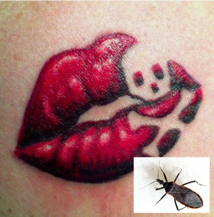
In The Beginning!
It was about 2:00 am that I woke up, scratching my scalp. Within minutes, my entire body was itching uncontrollably. My heart was pounding, and my mouth swollen. My commotion woke up Carol and I asked her if we had bed bugs. A look in the bathroom mirror scared me as a rash had broken out. We got out of bed and shook the blanket. And there it was, falling to the floor, a bloated kissing bug. Bloated with MY blood. I downed a half bottle of Benadryl and the itching subsided, but I don’t think I fell back to sleep that night. The next day, I made an appointment with Dr. Jacob Pinnas, an allergist in Tucson who specialized in kissing bug bites. He told me that many people have an extraordinary sensitivity to kissing bug bites and he had more patients die from kissing bug bites than all the bee and wasp stings combined. And like bee keepers, some people become resistant to kissing bug bites with each exposure. But others, unfortunately, become more sensitive with successive bites and become susceptible to anaphylaxis. This is a bug to take seriously, so please read on!
What are kissing bugs?
They are hematophagous (blood-sucking) insects. They are true bugs, in the insect order Hemiptera. The family name is Reduviidae. They are also called cone-nose bugs, assassin bugs, and vampire bugs. In some countries of South America, inhabitants have historically battled a bloodsucking insect called vinchuca. Charles Darwin, who often slept on the ground in South American forests, reported being bitten many times by these kissing vinchucas. One hypothesis about the origin of Darwin’s poor health for the remainder of his life is that he contracted Chagas disease from the bugs. But, it’s just a hypothesis.
How many species of kissing bugs are there?
A lot! Approximately 130 species, all in the New World, with 11 species in the United States. The most common species in our area is Triatoma rubida. Here is a photo of the bug. Note the long “snout,” and the black rectangles embedded in an orange background on the abdomen.

Triatoma rubida
People often mistake another bug for a kissing bug. This is the leaf-footed bug, also called cactus bug (genus Leptoglossus) that is very common, and found in many homes. Note (in the photo below) the dilation on each rear leg (tibia). Although also a true bug, it belongs to a different family - Coreidae. In some areas it is an agricultural pest, but completely harmless to people.
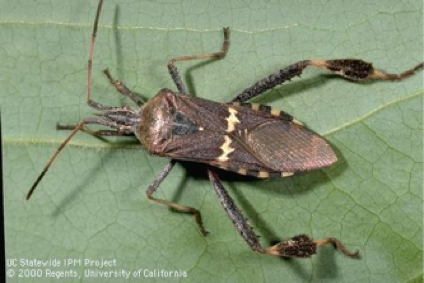
Leptoglossus
Where do kissing bugs live?
Kissing bugs in Arizona, particularly Triatoma rubida and Triatoma protracta, commonly infest packrat nests. But, they can also live:
• Beneath porches
• Between rocky structures
• Under cement
• In rock, wood, brush piles, or beneath bark
• In other animal burrows
• In outdoor dog houses or kennels
• In chicken coops or houses
In areas of Latin America where human Chagas disease is an important public health problem, the bugs nest in cracks and holes of substandard housing.
Are they seasonal?
We have (very) occasionally seen them during any month, even January. But they do have seasonal peaks of activity.
Before or during the summer monsoon rains they engage in dispersal (and mating) flights at dusk. Like many nocturnal insects, they are attracted to lights in houses. Dispersal flights can be up to one mile, so you don’t have to have pack rat nests near your home. With increasing urbanization, and the accompanying reduction in rodent populations, kissing bugs become even more reliant on humans for blood meals.
Once inside your house, what attracts them to YOU?
Kissing bugs have an extraordinary sensitivity to carbon dioxide, lactic acid, and several fatty acids, all excreted by people. They also detect infrared radiation (HEAT), enabling them to find you in any room.
If the bugs are in your house during daylight, they typically hide in a variety of crevices (furniture, mattresses, pillow cases, you name it).
Why are they called kissing bugs?
It is a very appropriate name for an insect that frequently bites people on the lips. The skin on our lips is very thin compared with other parts of the face, and the red color indicates that the copious blood supply is not far from the surface. But the bug is perfectly content to penetrate other parts of the face. After all, since our face is usually out in the open while we are sleeping, it’s the path of least resistance. Nevertheless, kissing bugs can “nail” you anywhere on the body. They do not bite through bed sheets or blankets.
What is the bite like?
Once a host is located, a hungry bug extends its proboscis and inserts it into the skin of the host. Small, serrated mandibles are then used to cut the epidermis. Finally, a sharp stylet is inserted though the mouthpiece to search for capillaries. Sometimes, the host detects the minor sensation caused by a kissing bug’s probing and moves or shifts position. A bug can take in more blood than its own weight, so feeding may last 1 - 20 minutes.
Why don’t we feel the bite?
We all have countless touch receptors on just about every part of our body, and many people do awaken to the stimulus of a kissing bug crawling on their skin. Experiments have shown, however, that the bite is essentially painless. This explains why most patients presenting to emergency rooms with anaphylaxis due to kissing bug bites are rarely aware of a bite preceding anaphylaxis – they awaken at night with intense itching over the body and difficulty breathing. If they don’t see the bug, they may attribute it to a spider (which CAN cause similar symptoms).
Chemicals in kissing bug saliva are able to inhibit voltage-gated sodium channels. Without getting technical, these channels allow many nerve cells (including pain receptors) to “fire,” sending signals to the brain. This chemical inhibition may account for the bug’s anesthetic effect.
Do both males and females feed on blood?
Yes. Unlike mosquitoes, in which females feed on blood and males drink nectar, both sexes of kissing bugs suck blood. And so do all 5 immature stages. Kissing bugs probably evolved from insects that fed on insect hemolymph (blood) and then changed to specialize on vertebrate blood.
What are the symptoms of a kissing bug bite?
The good news is that, for many people, a bite from a kissing bug is not much different than a mosquito bite. Itching, but no severe symptoms. But for some people, get ready for a LONG list!
A major salivary chemical (antigen) in kissing bugs is called procalin, which can cause severe allergic reactions in humans. Other enzymes in the saliva prevent platelets from aggregating, thus maintaining an adequate flow of blood from the capillaries. Common symptoms include:
Hives
Nausea - Vomiting
Severe itching (locally, or entire body)
Constriction of the throat
The Romañia sign (swelling of the eyes)
Swelling of the tongue and throat
Difficulty swallowing, speaking, breathing
Dangerous drop in blood pressure (shock)
What is the treatment for a kissing bug bite?
For mild symptoms such as itching, an over the counter antihistamine medication like Benadryl should be sufficient.
But note that the more severe symptoms listed above are indications of ANAPHYLAXIS, a severe allergic reaction that needs to be treated right away. If you have an anaphylactic reaction, you need an epinephrine (adrenaline) shot as soon as possible, and someone should call 911 for emergency medical help. Left untreated, it can be deadly. Keep an EpiPen in your medicine chest, and make sure it has not expired. They used to be extremely expensive ($300), but CVS now sells a generic version - a 2-pack for about $100.00. Get a prescription from your health care provider and GET IT! It could save your life.
Is it easy to find the bug in my bed?
After a blood meal, the bug is swollen and quite lethargic. Indeed, it can barely move. Shake out your blankets, pillow cases, and sheets, and the bug should fall onto the floor.
What’s the life cycle?
Kissing bug eggs hatch into wingless nymphs, of which there are five stages, each stage requiring at least one blood meal to molt. The fifth immature stage molts to a winged adult that, when given the opportunity, feeds every several weeks, or even more than once a week, depending upon ambient temperature and season of the year.
Are humans the only species bitten?
Nope. They bite a large variety of animals, including dogs and other mammals, birds, reptiles, amphibians, and even some invertebrates. Kissing bugs can be a serious pest on dogs. Bravecto (and similar products) is a flea-and-tick-killing medication that provides dogs with protection. The active ingredient in the medication is fluralaner, which is a systemic ectoparasiticide (meaning that it kills bugs that live on the outside of your dog’s body). There is some evidence that it will also kill kissing bugs, but I have not seen a published study.
How can I keep kissing bugs out of my house?
Short answer: it ain’t easy!
Synthetic pyrethroid sprays have been used successfully in Latin America to eliminate house infestations. The fact that, in our neck of the woods, bugs are found indoors only occasionally, suggests they are NOT living (and breeding) inside our homes. Accordingly, chemical sprays and professional pest control operators are unnecessary (and unhealthy).
Note that roach hotels or other "bait" formulations do not work against kissing bugs.
Precautions to prevent house infestation include:
• Sealing cracks and gaps around windows, walls, roofs, and doors
• Removing wood, brush, and rock piles near your house
• Using screens on doors and windows and repairing any holes or tears
• If possible, making sure yard lights are not close to your house (lights attract the bugs)
• Sealing holes and cracks leading to the attic, crawl spaces below the house, and to the outside
• Having pets sleep indoors, especially at night
• Keeping your house and any outdoor pet resting areas clean, in addition to periodically checking both areas for the presence of bugs
. Remove pack rat nests from around your house. I have found 2-18 kissing bugs living in a single packrat nest.
Recent research has demonstrated that Citronella oil is a promising potential repellent to prevent sleeping people from being bitten by kissing bugs. One published study found the repellent activity of citronella oil appears to be acting through direct contact with the bugs rather than diffusion of vapors. So, what are you supposed to do? Rub it on your body before bedtime? Good luck with that!
How can I keep kissing bugs off of me?
As long as you live and breathe, kissing bugs can find you. Several people in Portal, who know from experience that they are sensitive to kissing bug bites, sleep under a ceiling-to-floor bed net. They are inexpensive $10.00 - $75.00 and come in several styles. If you have 4 posts at the corners of your bed, some models attach to the poles. Otherwise, you can purchase a net that attaches to the ceiling (with a hook) over the center of the bed, and drapes down. Make sure you get one large enough to tuck under all sides of the mattress. Using the net during the months of May-July should offer sufficient protection. This what Carol and I sleep under during these months.
What is Chagas disease?
Chagas disease (named after the Brazilian physician Carlos Chagas), is caused by the protozoan parasite Trypanosoma cruzi (see photo below), which is transmitted to animals and people by kissing bugs and is found only in the Americas (mainly, in rural areas of Latin America where poverty is widespread).


Chagas disease has an acute and a chronic phase. If untreated, infection is lifelong.
Acute Chagas disease occurs immediately after infection, may last up to a few weeks or months, and parasites may be found in the circulating blood. Infection may be mild or asymptomatic. When signs and symptoms do occur, they are usually mild and may include:
• Swelling at the infection site
• Fever
• Fatigue
• Rash
• Body aches
• Eyelid swelling
• Headache
• Loss of appetite
• Nausea, diarrhea or vomiting
• Swollen glands
• Enlargement of your liver or spleen
A particularly interesting symptom of the acute phase is called the Romañia sign, a preorbital swelling of the eye (see photo below). The Romañia swelling can also be present as part of the allergic reaction following a bite near the eye!

The Romaña Sign
Following the acute phase, most infected people enter into a prolonged asymptomatic form of disease, during which few or no parasites are found in the blood. During this time, most people are unaware of their infection. Many people may remain asymptomatic for life and never develop Chagas-related symptoms. However, an estimated 20 - 30% of infected people will develop debilitating and sometimes life-threatening medical problems over the course of their lives.
Complications of chronic Chagas disease may include:
• heart rhythm abnormalities that can cause sudden death;
• a dilated heart that doesn’t pump blood well;
• a dilated esophagus or colon, leading to difficulties with eating or passing stool.
How does the kissing bug spread the parasite that causes Chagas disease?
The insect vector transmits the parasite to hosts by biting and subsequently defecating near the site of the bite. The parasites live in the digestive tract of the bugs and are shed in the bug feces. When infectious bug fecal material contaminates the site of the bug bite on a mammal, transmission of the parasite can occur. So far, at least 8 species can transmit the trypanosome.
While transmission of T. cruzi by kissing bug bites is the most common form of disease acquisition, Chagas disease can be acquired congenitally, through blood transfusion, organ transplantation, and ingestion of contaminated food or drink.
Many species of animals upon which kissing bugs feed can serve as a source of parasite infection to the bug, and the Trypanosoma cruzi parasite has been found to infect domestic dogs, humans, opossums, wood rats armadillos, coyotes, mice, raccoons, skunks, and foxes. Wildlife are responsible for maintaining this parasite in nature. Therefore, Chagas disease emerges at the intersection of wildlife, domestic animals, humans, and vector populations.
Since T. cruzi is transmitted to humans through the feces of the bugs, the delayed defecation and movement away from the host are likely one reason transmission of Chagas disease from these species is less likely than from South American kissing bugs.
What is the status of Chagas Disease inn The United States?
An estimated 5.7 million people are infected with Chagas disease worldwide. The Centers for Disease Control and Prevention (CDC) estimates that approximately 300,000 people are living with this disease in the United States. Roughly 30% of those infected will develop serious cardiac, digestive, or neurological disorders. Most are immigrants from Latin America, have Chagas Disease in its chronic phase, and can therefore transmit the parasite to kissing bugs.
The most recent epidemiological investigation to back up the CDC estimate was a study of almost 5,000 Latin American-born residents of Los Angeles County. It found that 1.24% tested positive for Chagas disease.
The good news so far is that very few individuals have contracted the disease from bites in The United States. This may be due to a behavioral difference between the bug species here and in Latin America. The species here don't defecate while they are feeding. This delay prevents the trypanosome from being rubbed into the wound created by the bite. But most experts agree that it would only take a minor genetic change to produce bugs that do defecate while feeding. When that happens, we will have a major disease outbreak. There is currently no vaccine for Chagas Disease.
Do trypanosomes cause any other human diseases?
In Africa, a different species of the protozoan transmits sleeping sickness, via the bite of the tsetse fly.
Does Chagas Disease affect dogs?
In dogs, infection with the Chagas parasite can cause severe heart disease, however many infected dogs may remain asymptomatic. The degree of complications relate to the dog’s age, activity level, and the genetic strain of the parasite. Testing for canine Chagas disease is by means of a blood test. Unfortunately, treatment options are not readily available, although some research teams are developing new treatment approaches that are promising. There is currently no vaccination that protects against Chagas disease for either dogs or humans.
Why are dogs at risk of being infected?
High densities of dogs in confined areas are associated with heat and carbon dioxide that attract kissing bugs that seek blood meals. Furthermore, dogs may easily consume kissing bugs in kennels. Because adult bugs fly towards lights, keep kennel areas dark after sunset. Some insecticides are effective against kissing bugs when sprayed around the kennel area.
Can we get Chagas Disease from other mammals?
Good question!
In the United States, at least 24 mammal species have been documented as hosts of Trypanosome cruzi. Evidence suggests that all mammals may be considered as susceptible to infection. What if an infected, and rabid, dog, fox, skunk, etc. bites a human? This is a great question but it has never been studied. Could be a great Ph.D. thesis project.
Kissing Bug Stories
This “Kiss Of Death” web page is a work in progress, and I intend to update it as new studies are published. An interesting feature will be posting your experiences with kissing bugs, so please do send me some juicy stories.
July 13, 2013 - by H. Topoff
My Animal Behavior Class excavated a pack rat nest near my home. First we erected a mosquito tent over the nest, to capture any insects attempting to fly away. By the end of the excavation, we had extracted 18 kissing bugs from that single nest! Pity the poor rat.
May 29, 2017 - by H. Topoff
Carol did a wash two days ago and piled my clean clothes on the dresser near our bed. After a jog an hour ago, I showered and attempted to dress. As I was putting on a clean pair of underwear from the pile, this kissing bug fell from inside the shorts to the floor. This is shaping up to be a bad year for kissing bugs. Maybe we'll have dinner tonight inside our bed net!
May 31, 2017 - by Mark & Diana Jankowski
About 10 years ago we spent a couple of nights at the blue cottage, just off Portal Road, and were invaded by a swarm of these reduviids. They were landing on any area of exposed skin, especially on our face and head. We were able to isolate ourselves from the horde of assailants by remaining inside the cottage and methodically destroying every individual we could find. Yes, they do hide under beds and behind curtains! To the best of our knowledge we were not bitten, but the enemy suffered heavy losses.
May 31, 2017 - by Bill Cavaliere
Every time I get bitten by a kissing bug, the reaction gets worse. Early bites were extreme itching confined to the area of the bite. Then the areas would get progressively larger.
One night I woke suddenly to find my entire body swollen from head-to-toe, itching all over like I had never experienced before. We found a kissing bug on the bed and shook it onto the floor. When my wife stepped on it, it spurted blood. Then my lips started to get numb and I had difficulty swallowing. Every inch of skin on my body itched terribly. My wife gave me a Benadryl and after a while the itching subsided a little and the swelling went down.
May 31, 2017 - by Delane Blondeau
A couple of early evenings ago I was bitten by a kissing bug. The spot turned red and itched like crazy. I thought the stick you can buy for bug bites has alcohol in it, I think, so I took a pad of toilet paper and soaked it with rubbing alcohol and placed it on the spot for maybe 2 minutes. The red remained, but the itching stopped and did not come back – even in a warm shower. The red is fading away. When I pulled the sheets off the bed on laundry day, there was a fat kissing bug that came up from between the mattress and the headboard with the sheet. Aha, a RESIDENT (about 4 days after my bite.) He was fat with my blood (I think she ). But now departed this life!
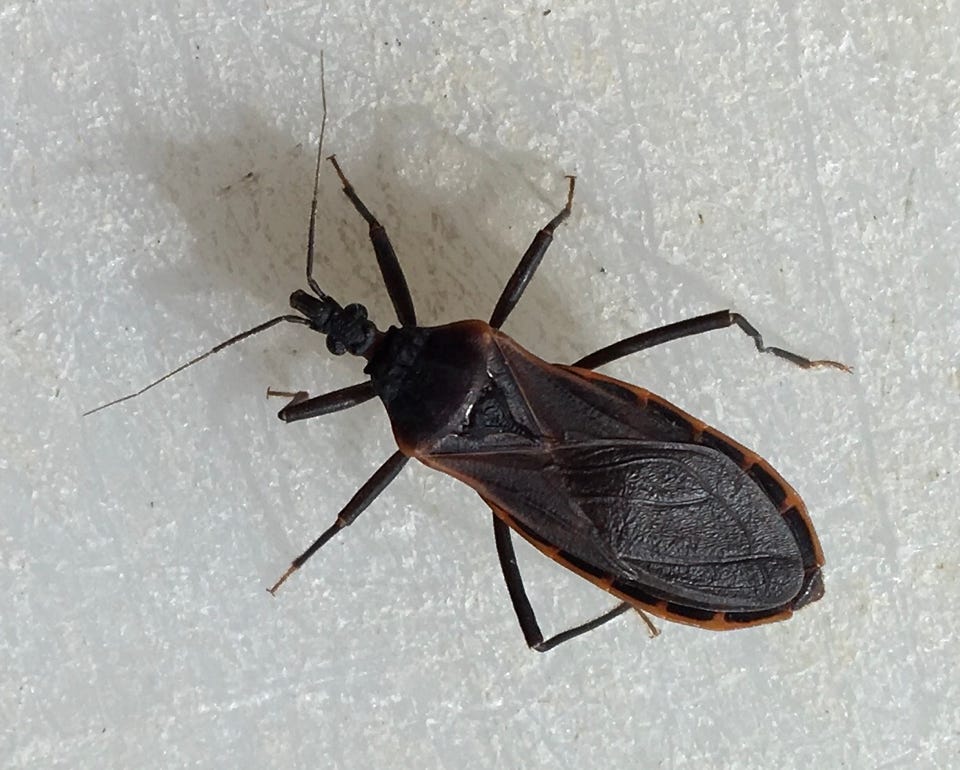
In my underwear!
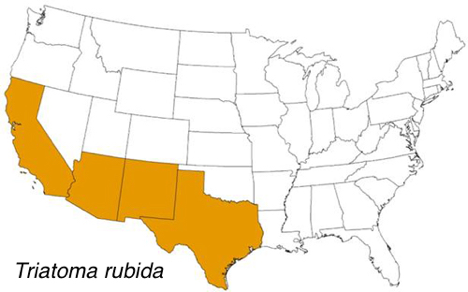
Distribution Of Species Most Common In Portal-Rodeo

Distribution Of The 11 Kissing Bug Species In The United States
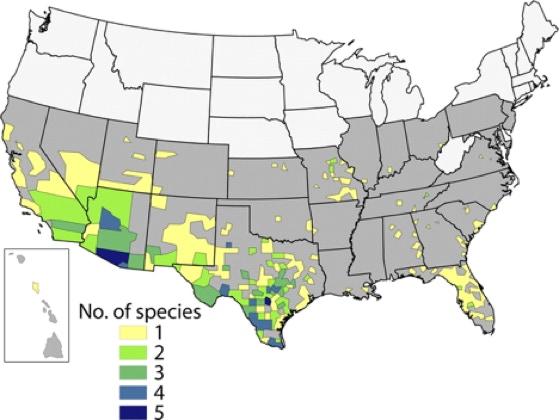
Occurrence Of Chagas Disease In The United States
(Colors Denote Number Of Kissing Bug Species)
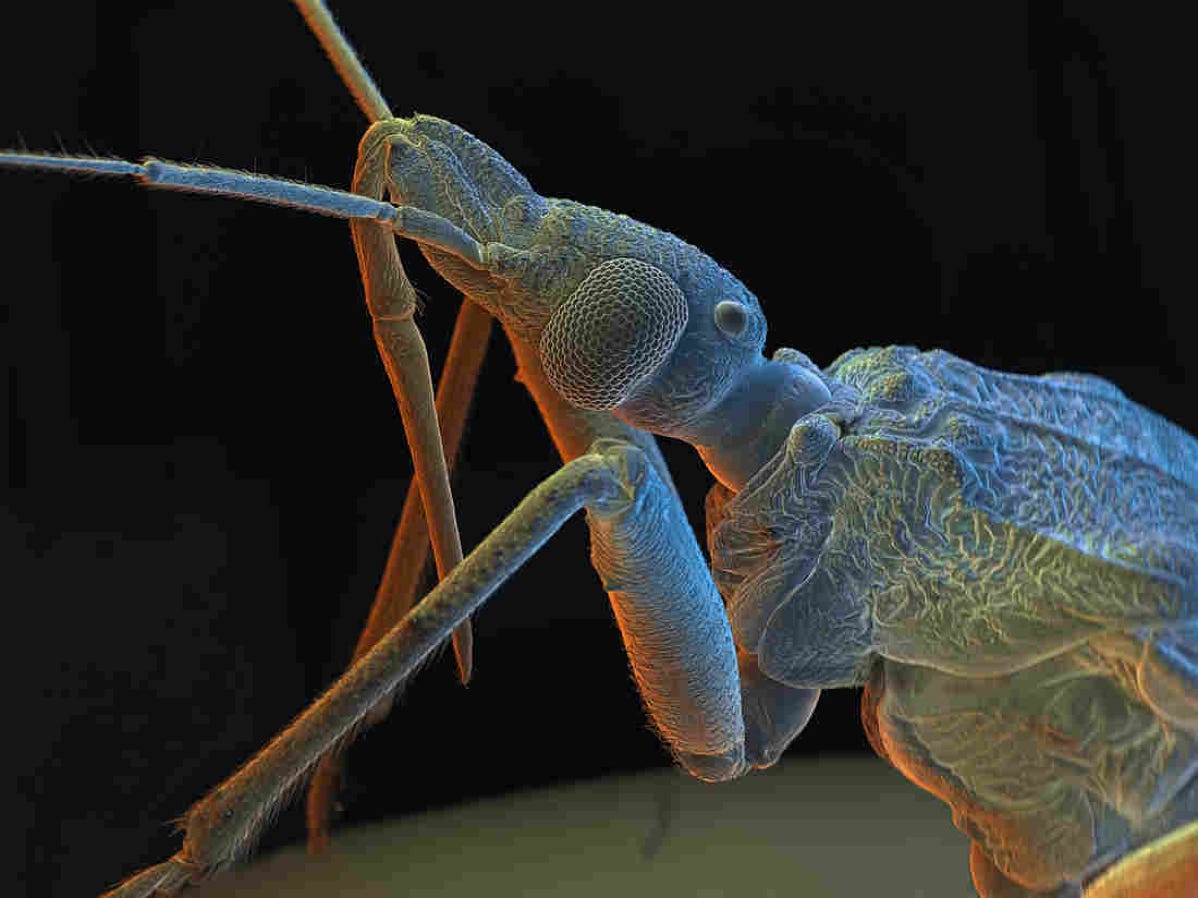
A Thing Of Beauty Is A Joy Forever
_____________________________________________
Scientists have their eyes on Chagas disease and the 'kissing bugs' that help spread it.
Chagas disease can lead to heart failure and damage to the esophagus and gastrointestinal tract. Roughly 20-30% of those who contract Chagas may be at risk of dying from it.
Emily Pollom is a biologist, fascinated by living things, and it shows as she gives me a tour around her property in rural southwestern New Mexico. She points out the little details about the local flora and fauna, lost on most of us, before she starts to clean up a midden, a nest, built by woodrats.
“These are the pallets, they love pallets. Absolutely love them,” Pollom said.
These rodents — about the size of a city rat — live all over the Southwest. Their handiwork, the middens, are piles of debris you might find under your car hood (yes, they can get in there) or in your backyard. Or, in Pollom’s case, under wooden pallets near her front door.
But Pollom isn’t really concerned about the messy nest: What she’s worried about is kissing bugs. They ravenously feed off these packrats and reproduce ever more offspring shortly afterwards.
Kissing, conenose, or vampire bugs — triatomines to be scientific — are a group of 130 different species of insects. If you live in the Southwest or the South, you’re probably familiar with them. They look like beetles with long snouts, and they’re bloodsuckers. But unlike mosquitos or ticks or even biting flies — you usually don’t even know if you’ve been bitten by them unless you’re allergic to their saliva. Their bite itself is painless.
The problem with these kissing bugs is that they can carry a parasite known as Trypanosoma cruzi — T. cruzi for short — which can cause Chagas disease.
“That parasite is very, very tricky. [The] parasite is very complex, in its life stage, in its transmission from the triatomine,” said Rosa Maldonado, professor of microbiology at the University of Texas at El Paso.
“You can live with this disease — think 20, 30 years — before you know that you are sick,” Maldonado said about Chagas.
Those who are infected with T. cruzi and then develop Chagas can eventually suffer from heart failure and damage to their esophagus and gastrointestinal tract. Roughly 20-30% of those who contract Chagas may even be at risk of dying from it.
A few years ago, the World Health Organization estimated that between 8-10 million people worldwide suffer from Chagas, mostly in Latin America, particularly in Bolivia and elsewhere in South America.
Here in the U.S., estimates have the numbers as high as 300,000 people being infected with the T. cruzi parasite, although most experts believe that the majority of these cases were contracted abroad — outside of the U.S. That said, all these human infections came from blood-sucking kissing bugs.
As vector-borne diseases go, however, it doesn’t at first glance seem like the most efficient mode of transmission.
“Kissing bug is not a very efficient vector of Chagas disease. [Kissing bugs] have to feed on you, they have to defecate,” said Jane Pierce, an entomologist at New Mexico State University. She points out that the parasite passes through the insect’s fecal matter — its poop — before entering its human host via a bite. In Latin America, food and drink contaminated with the bugs’ feces are themselves major modes of transmission.
“It’s really a lousy vector … it really is,” she said.
The estimated number of locally acquired Chagas cases in people in the U.S. is low— likely 10,000 or less — although all such estimates are rough. But the disease is passing on to other warm-blooded creatures here, as Pierce points out.
“Dogs are at very high risk,” she said.
Recent studies of dogs in Texas are very sobering. In big kennels up to half of the dogs have been found to carry the parasite. This doesn’t mean that all of these dogs have Chagas disease, but many do, and scientists are increasingly documenting cases where dogs die from the disease.
Rosa Maldonado has been monitoring the prevalence of T. cruzi in kissing bugs and other animals at her lab at the University of Texas at El Paso. She and her team have collected kissing bugs and samples from wild animals, including feral dogs, at several sites in Texas and New Mexico. They’ve found that both showed high rates of T. cruzi infection.
They also identified blood samples from those T. cruzi-positive bugs and found that indeed packrats, dogs, and, yes, humans had been fed upon at some point in their life cycle.
Epidemiologists emphasize that it’s not that Chagas disease is the next major epidemic in the U.S. — certainly not on the order of COVID-19. But researchers also don’t really know the magnitude of the threat. There’s very little understanding of just how many people who have immigrated from parts of Latin America, where Chagas is prevalent, are living with the disease and just aren’t being screened.
“I feel like oftentimes the people that are mostly exposed or mostly affected are coming from places where they don’t have access to medical care,” said Paula Granados-Stigler, associate professor of environmental health at San Diego State University and longtime Chagas researcher.
“I think that there’s going to be a lot of missed diagnoses — it’s a very underdiagnosed disease here in the United States. And the disease is a bit complicated in that you can be infected with the disease or the parasite, have no symptoms and live your entire life completely symptom free,” she adds.
The disease is indeed complicated. Not everyone who carries the parasite contracts Chagas disease. And not everyone who has Chagas will have the most troubling symptoms like heart failure. Yet 60-70% of people may be living with it in an indeterminate phase where they don’t develop severe symptoms right away. It could take 20-25 years for this to happen. After this latent period, severe damage has been done to the patient’s body. This can include the need for a heart transplant or having to live with a severely damaged colon. And, of course, the possibility of death.
This is the reason public health practitioners and doctors emphasize monitoring and screening.
“Do we have the resources to screen everybody? No. Is it so prevalent that we should be screening everybody? No. But definitely targeting places where we think there’s a higher risk? Yes,” Granados-Stigler said.
All of this speaks to the social determinants of health. That your race, ethnicity, class, gender identity, or immigration status may determine the type of health outcomes you receive. Because the burden of disease is overwhelmingly felt by Latino and low-income populations, many public health experts aren’t so concerned about massive new transmission in the U.S.; rather, they often seem as much concerned about the people who could already have the disease. This includes mothers who may pass T. cruzi on to their children congenitally.
And it’s not only that monitoring and testing for Chagas are rudimentary compared to much better-known diseases in the U.S., it’s also that the drugs used to treat acute Chagas come with serious side effects. Some U.S. states, like my native New Mexico, don’t even list Chagas as a reportable disease. And all of this often assumes a patient has access to the health care system — a bit of a stretch for many living in poverty or afraid of entering it as immigrants who are undocumented.
“We have a policy of containment,” said Daisy Hernández, an English professor and author of the book “The Kissing Bug,” which is equal parts personal memoir and journalism on how underserved populations fall through the cracks when they have a disease like Chagas.
“And once a disease is contained to a marginalized or vulnerable group, we are pretty satisfied as a whole. No one says that publicly,” Hernández said.
We may never know for sure how big a threat Chagas is for hundreds of thousands of people in the U.S. — even if we very well do know how big it is in Latin America. But kissing bugs that crawl among us here are vectors for the parasite, as animals like dogs and packrats make very clear.
We also know that kissing bug bites can cause serious allergic reactions, up to anaphylaxis, which alone is a reason to control their infestations around our homes.
Emily Pollom, the biologist who is always scanning her property in rural New Mexico for kissing bugs, knows this all too well. Her partner, John Gorey, also a biologist, is a perfect example. He had a particularly nasty encounter with kissing bugs a few years ago.
“I didn’t know what was going to happen with me after the bite because I was feeling really hot. I was starting to actually get hives and my entire body started to itch and I didn’t have any breathing difficulties, but it seemed like that was the next step,” Gorey recalls.
As a result, Pollom and Gorey have been working to increase awareness of kissing bugs and the potential threat they pose, while always keeping things in perspective.
“The way I feel about the risk of Chagas, I guess, in my own life with the kissing bugs that are around my own home is that it’s important for me to be aware and develop measures for being cautious. But I don’t feel afraid all of the time. [The] fear that we have is much more having to do with the allergy than from the the risk of Chagas,” Pollom said.
In this way, a whole host of hardworking scientists, doctors, activists, and even writers are doing the same about the larger threat of Chagas. It could well be through their efforts that many will have less fear of a painless nibble in the middle of the night.